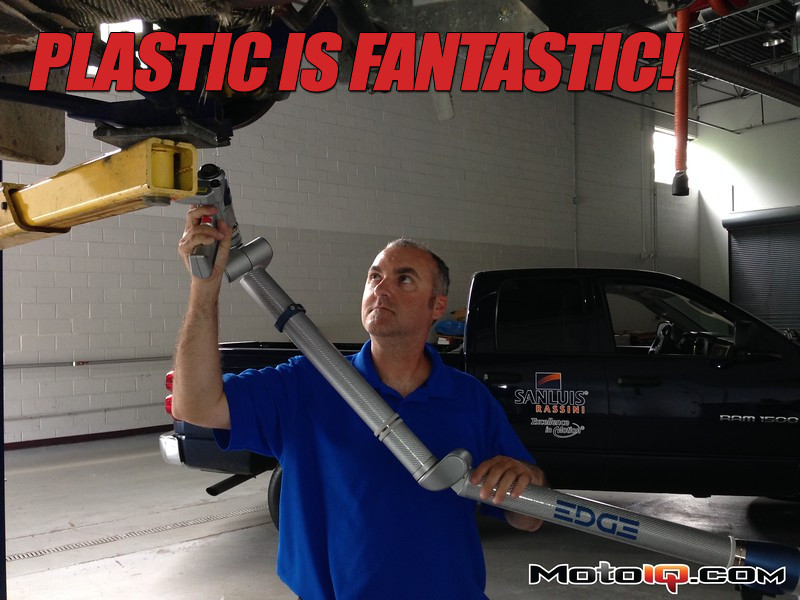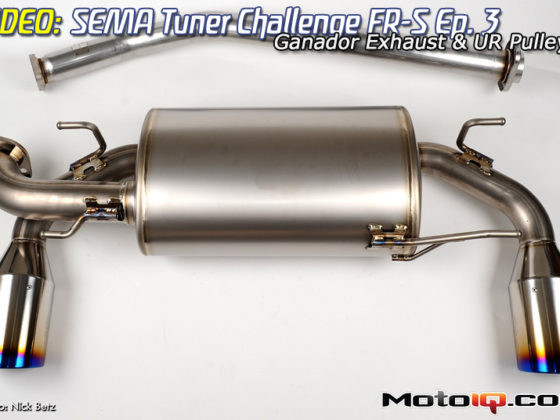,
Here’s the problem – we’re down to only six weeks until showtime. The car has to be driveable by then, which means we have lots of parts to fabricate from scratch. As I mentioned, we’ve also decided to paint her as well. Even though there’s no rear suspension in the car, we went ahead and put it on a dolly so that it could be towed to the body shop. We’re committed (or should be by now). We won’t have the body handy in case any questions come up, and you can be sure there will be some things that will! We’ll just have to deal with them as best we can with the data we have.
 This is what fiberglass roving looks like –it’s basically just a bundle of fibers, held together with a chemical treatment, called “sizing”
This is what fiberglass roving looks like –it’s basically just a bundle of fibers, held together with a chemical treatment, called “sizing”Time to step back and talk a little more about composites. As I mentioned in the first installment of the GT Lite project, composites generally consist of a reinforcement, like carbon fibers, and a resin, like epoxy. The resin can sometimes be a two-part chemistry, that, once mixed together, starts a chemical reaction that generates the heat required to harden (cure) itself. The resin may also be of a chemistry that requires external heat to perform the curing. In any case, composites that require heat to cure are generally referred to as thermoset composites. The liquid resin is combined with the fiber, a process called impregnation, and is usually placed in some type of mold or over some type of form that has the desired shape, and then allowed to react and cure for the allotted time. In many cases, the impregnated materials are put under pressure during the cure, such as in a compression mold or autoclave, or in a vacuum environment (vacuum bagging) in order to remove any voids or air bubbles.
This process is referred to as “consolidation,” and results in a stronger part. In the case of resins that require external heat to perform the cure, the impregnated material may be carefully stored and used at a later time. These pre-impregnated materials, or “pre-pregs,” can then be exposed to external heat and/or pressure or vacuum to perform the curing. Once the material cures, it retains the shape of the tooling. There are some limitations to the process. Usually the chemicals must be carefully stored and are subject to shelf-life limitations. Many are hazardous to work with, and may emit toxic fumes or irritate the skin, eyes, and mucous membranes. Some of them are considered environmentally unfriendly, and are subject to strict regulation. Cure time, at best, is usually many minutes, if not hours. Another drawback is that once cured, there is generally (to quote Goggles Paisan again), “no turning back.” Once a part has cured, it’s usually difficult, if not impossible, to change the final shape.
 As you can see, there are literally hundreds of individual fibers in a roving, each fiber thinner than a human hair. So tiny, in fact, that they easily penetrate the skin, which is why you can get a case of the “itchies” when you cut, grind, or handle glass fibers. Some people are more sensitive than others, but it’s generally not harmful – just irritating.
As you can see, there are literally hundreds of individual fibers in a roving, each fiber thinner than a human hair. So tiny, in fact, that they easily penetrate the skin, which is why you can get a case of the “itchies” when you cut, grind, or handle glass fibers. Some people are more sensitive than others, but it’s generally not harmful – just irritating.While we have decades of experience with thermoset composites (our sister company was one of the earliest composite manufacturers in the world, incorporated back in the early 1950’s), we will be focusing on a different class of materials for this project – thermoplastic composites. Thermoplastic resins are plastic resins that are liquid at higher temperatures, and, once cooled, they solidify again. Many times the resins are common, everyday plastics – like polyethylene, polypropylene, and nylon. These types of composites are usually made by heating the resin until it melts, combining it with the reinforcing fibers, and then cooling the combined materials. It’s pretty simple in theory, but in practice it tends to be tricky to do successfully. There are big benefits to these types of composites, though. First and foremost – they can be heated, reshaped, and cooled. If done carefully, this can be done more than once with essentially no loss in strength. This means that thermoplastic composite materials can be pre-made in rolls or sheets, and then stored and formed into their final shape at a later time. Second – there are almost never any environmental issues. No harmful vapors, no special storage requirements, and almost indefinite shelf life. Third – the cure time is fast. Thin parts can literally be heated, shaped, and cooled within seconds, with big assemblies taking only minutes. If it is cool enough to touch, it’s usually ready to use.
 This package of PPG fiber is actually a single roving – it’s all one “yarn,” and this typical spool is actually over five continuous miles long!
This package of PPG fiber is actually a single roving – it’s all one “yarn,” and this typical spool is actually over five continuous miles long!Composites typically achieve their high strength and stiffness from the reinforcement material, usually a fiber. Things like glass or carbon fiber are very stiff and strong for their size, but since they are so small in diameter (thinner than a human hair), you need lots of them to achieve the strength level you want, and you need a way to hold them all together in a consistent fashion so that they work together as a unit – and that’s where the resin comes into play. The resin binds the fibers together, and can also serve to protect the fibers from things like impact, corrosion, and ultraviolet radiation.
 Unlike the two-part liquid resins that thermoset composites typically use, we are working with thermoplastics. This is the form of the plastic resins we use – pellets.
Unlike the two-part liquid resins that thermoset composites typically use, we are working with thermoplastics. This is the form of the plastic resins we use – pellets.



1 comment
Hi, I’m Eric Chin. Technology manager of Avient Taiwan.
We have a TPU film manufacturer who is interested in the PolyStrend technology and they would like to ask if this technology can combine with their TPU laminated film product to achieve extra strength and light weight.
Would you provide a suitable technical contact window for further discussion with the technical part with our customer?
Thanks and Regards